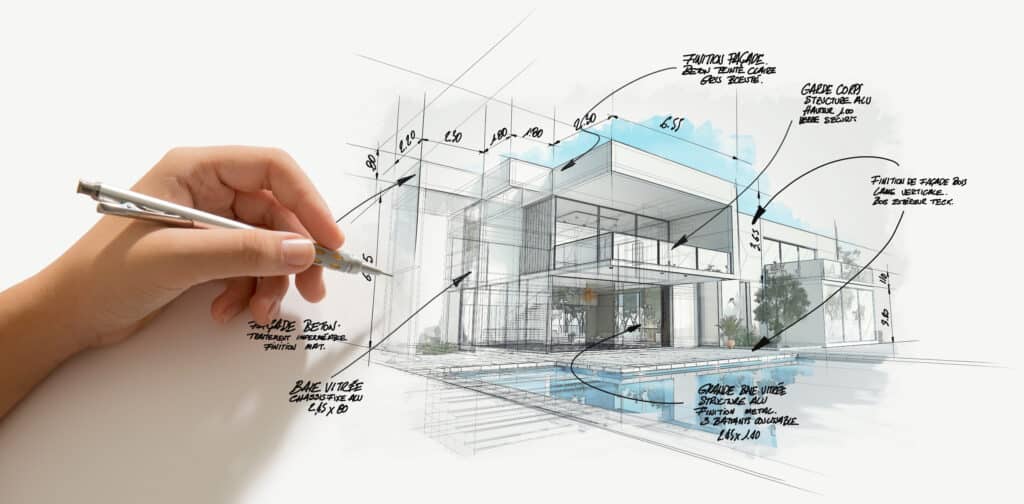Architect Career Path: Competencies, Training, and Growth Guide
Architect Career Path: Competencies, Training, and Growth Guide
Blog Article
Understanding the Diverse Job Paths Available for Aspiring Architect
As an aspiring Architect, you have a globe of career paths waiting for you. Whether you're drawn to standard style or the nuances of sustainable style, there's a particular niche that aligns with your rate of interests.
Typical Architecture: Designing Structures and buildings
Standard style concentrates on developing structures and structures that blend capability with visual appeal. As you discover this area, you'll appreciate the detailed equilibrium between kind and objective. You'll find out to draw motivation from historic styles, incorporating elements like proportion, products, and workmanship. Your styles can show cultural heritage, showcasing local traditions while satisfying modern-day demands.
You'll develop abilities in composing, model-making, and website analysis, allowing you to imagine and communicate your ideas efficiently. Engaging with clients, you'll require to recognize their vision and convert it into possible styles.
Moreover, developing codes and sustainability methods are necessary in your job, guaranteeing your structures are eco pleasant and risk-free. As you grow in your job, you'll discover chances in property, commercial, and even reconstruction jobs, each offering distinct challenges. Welcoming typical style leads the method for a satisfying occupation that admires the past while forming the future.
Urban Planning: Forming Communities and Public Spaces
As an ambitious Architect, you can play a vital role as a metropolitan planner, changing how areas engage and function. By using neighborhood engagement strategies, you'll guarantee that locals have a voice in forming their atmosphere. Plus, integrating lasting style concepts will assist produce rooms that not just meet today's requirements yet also secure the future.
Role of Urban Planners
While lots of could assume of architects as the single visionaries behind buildings, city planners play an essential role in forming the broader landscape of communities and public areas. By working together with numerous stakeholders, you'll help design parks, transportation systems, and property locations that advertise social interaction and availability. Your experience in spatial layout and neighborhood dynamics allows you to envision future development while protecting cultural heritage.
Community Involvement Approaches
Reliable community interaction approaches are vital for urban coordinators to ensure that the voices of homeowners are heard and valued in the planning process. To cultivate significant discussion, you should focus on open discussion forums and workshops where community members can share their concepts and concerns. By actively incorporating and paying attention responses, you'll create spaces that reflect the neighborhood's demands, ultimately leading to more lasting and effective metropolitan environments.
Sustainable Style Principles
When designing city spaces, incorporating sustainable design concepts is critical for producing environments that thrive both environmentally and socially. Think about integrating environment-friendly areas, like parks and gardens, to enhance biodiversity and boost air high quality.
Designing with water preservation in mind is also key-- consider rainfall gardens and absorptive surface areas to take care of stormwater. Including community participants throughout the preparation process warranties that the spaces you develop meet their demands and encourage social communication. By embracing these principles, you'll add to vibrant, lasting urban landscapes that benefit every person.

Landscape Architecture: Creating Lasting Outside Environments
As you discover landscape design, you'll find essential layout concepts that create useful and stunning outdoor rooms. Sustainable practices play a crucial role in ensuring these settings thrive while minimizing ecological impact. And also, you'll find a selection of profession possibilities that enable you to make an actual difference in just how people connect with nature.
Design Concepts in Landscape
Understanding design principles in landscape design is crucial for developing lasting outdoor environments that harmonize with nature. You'll need to contemplate elements like balance, range, and proportion to guarantee your designs feel natural and welcoming. In addition, pay attention to seasonal changes, creating with products that enhance the environments year-round.
Lasting Practices Summary
Sustainable techniques in landscape architecture not only concentrate on aesthetics yet likewise prioritize ecological health and source conservation. You can create rooms that advertise soil health, such as using organic materials and exercising permaculture principles. Inevitably, these techniques guarantee your layouts benefit both individuals and the atmosphere for years to come.
Occupation Opportunities Expedition
With a strong structure in sustainable methods, landscape architecture uses a selection of occupation courses that permit you to make a purposeful effect on the setting. Urban coordinators frequently work together with landscape architects to create environment-friendly areas in urban settings, boosting city livability. If you're passionate concerning education and useful link learning, take into consideration coming to be a landscape design teacher, motivating future generations.
Lasting Design: Concentrating On Eco-Friendly Practices
As you discover your occupation in style, accepting green practices can set you apart in a competitive field. Sustainable design concentrates on developing buildings that lessen environmental effect while enhancing passenger health. By incorporating eco-friendly materials, energy-efficient systems, and sustainable structure techniques, you'll add to a greener future.
Beginning by acquiring expertise of green qualifications like LEED or BREEAM, which can reinforce your qualifications. Take into consideration how all-natural light, air flow, and thermal performance can optimize style. Team up with designers and environmental specialists to introduce remedies that reduce waste and conserve resources.
Do not neglect the importance of community participation-- interesting local stakeholders can inspire layouts that integrate with the environment. As clients increasingly prioritize sustainability, your knowledge in green practices will not only attract projects but likewise satisfy your enthusiasm for accountable design. Accept this critical facet of the career, and see your job grow.
Historical Conservation: Safeguarding and Recovering Social Heritage
While you start on your building trip, think about the vital function of historic preservation in maintaining our social heritage. This area concentrates on the security and remediation of considerable buildings, websites, and frameworks that tell the stories of our past. By involving in historical preservation, you'll help safeguard the building tradition that shapes community identification.
As a historical preservation Architect, you'll assess historical significance and examine the condition of frameworks. You'll work very closely with preservationists and historians to assure authentic restoration strategies are employed. This job path permits you to blend creative thinking with research study, allowing you to develop solutions that appreciate original materials and workmanship.
Your work not just adds to sustainability by recycling existing structures however also promotes a feeling of satisfaction within areas. Embracing this course will assist you come to be a guardian of history, protecting the tales and aesthetics that enhance our lives.
Inside Design: Enhancing Indoor Spaces
Historical conservation and interior style both share a commitment to boosting the built atmosphere, yet they focus on various aspects. While historical conservation stresses keeping a structure's historical and cultural worth, indoor style zeroes in on optimizing indoor areas for capability and appearances.
As an aspiring Architect, you'll find that interior design permits you to mix creativity with technical skills. You'll develop areas that not just look good however additionally advertise convenience and performance. This area involves understanding exactly how light, shade, and products connect within a room, affecting mood and functionality.
You'll deal with numerous tasks, from residential homes to commercial offices, making sure that each setting meets the requirements of its owners. By prioritizing user experience, you can transform insides into motivating Architect and functional spaces, making a substantial influence on just how individuals connect with their environments. Embrace the opportunity to boost indoor atmospheres and shape the way people live and work.
Industrial Design: Merging Capability With Visual Appeals
Commercial layout plays a crucial duty in producing products that flawlessly mix aesthetic appeals with functionality, making certain that what you make use of daily is not just aesthetically appealing yet likewise useful. As an ambitious Architect, you could involve yourself in this area, concentrating on developing every little thing from furnishings to consumer electronic devices. Your job includes comprehending individual requirements, materials, and manufacturing processes, allowing you to create cutting-edge options that enhance everyday experiences.
In industrial style, you'll typically team up with designers, manufacturers, and marketing experts, ensuring that your designs are not only stunning but additionally possible. This career course uses a vibrant atmosphere where imagination satisfies functionality, making it a satisfying selection for architects interested in forming the products of tomorrow.
Regularly Asked Concerns
What Educational Qualifications Do I Required to Become an Engineer?
To become an engineer, you'll need a professional level in architecture, commonly a Bachelor's or Master's. In addition, you'll have to finish a teaching fellowship and pass the Architect Registration Exam to exercise legitimately.
Exist Accreditation Requirements for Various Architectural Career Paths?
Yes, there're accreditation demands for numerous architectural courses. Architect. You'll require to pass tests, complete teaching fellowships, and occasionally pursue specialized training, depending on your chosen focus, like landscape style, city layout, or historical preservation
What Software Abilities Are Crucial for Designers Today?

Just How Can I Gain Practical Experience While Examining Architecture?
You can gain functional experience by interning at building companies, joining style competitions, offering for neighborhood tasks, or collaborating with schoolmates on real-world jobs. These opportunities improve your abilities and develop beneficial links in the market.
What Task Opportunities Exist Outdoors Conventional Style Firms?
You can check out various job chances outside conventional design companies, like city preparation, interior decoration, landscape architecture, building and construction management, actual estate growth, or perhaps duties in sustainability consulting. Each deals unique challenges and rewards.
Whether you're drawn to standard design or the subtleties of lasting design, there's a specific niche that straightens with your rate of interests.When creating urban spaces, integrating lasting design concepts is crucial for developing environments that flourish both environmentally and socially.As you check out landscape architecture, you'll uncover crucial design principles that develop useful and stunning exterior rooms.Comprehending style principles in landscape architecture is vital for producing sustainable outdoor settings that balance with nature.In industrial style, you'll typically collaborate with engineers, producers, and marketing experts, ensuring that your designs are not only lovely however also viable.
Report this page